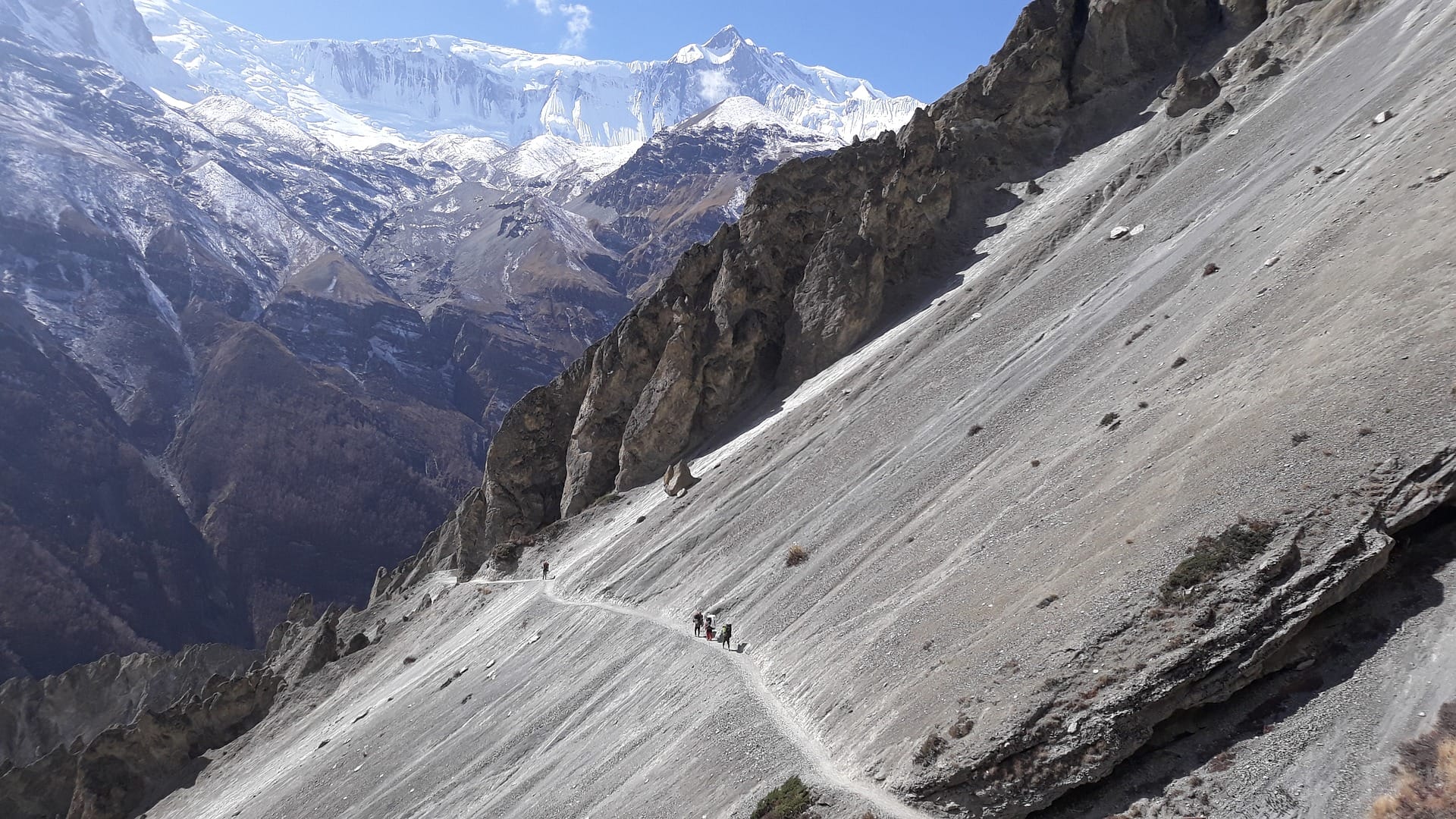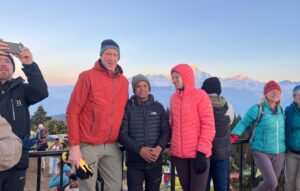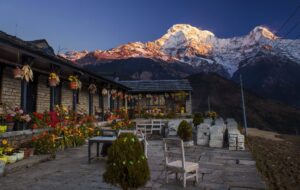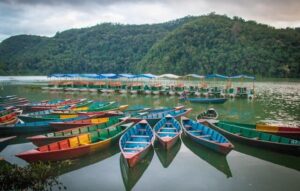Nepal, positioned between China and India in South Asia, is a paradise for trekking enthusiasts. With its stunning Himalayas, vibrant cultural heritage, and varied landscapes, Nepal provides some of the most awe-inspiring trekking adventures globally. Among the numerous trails available, the Annapurna Circuit shines as a quintessential trek, attracting adventurers from around the world. Moreover, the diverse landscapes and cultural richness encountered along this trail offer trekkers a uniquely immersive experience. Consequently, it stands out as a must-visit destination for those seeking both natural beauty and cultural depth.
Overview of Nepal as a Trekking Destination
Nepal’s diverse topography ranges from the lowland Terai plains to the towering peaks of the Himalayas. Furthermore, the country’s natural beauty and the hospitality of its people make it a trekking paradise. Each trek offers its unique set of challenges and rewards, catering to varying levels of expertise and interests. Consequently, trekkers can find routes that perfectly match their skills and preferences, ensuring an unforgettable experience in this stunning region.
Significance of the Annapurna Circuit
Nepal Trekking Adventures highlight the Annapurna Circuit as one of the premier long-distance treks worldwide. This iconic route circles the Annapurna massif, offering trekkers a diverse range of landscapes—from verdant subtropical forests and terraced fields to alpine meadows and arid high-altitude deserts. Moreover, it provides a trek that merges stunning natural beauty with deep cultural experiences, delivering a thorough immersion in the Himalayas. Consequently, adventurers can expect an unforgettable journey through some of Earth’s most breathtaking and culturally rich regions.
Brief Introduction to Other Popular Treks
While the Annapurna Circuit is a highlight, Nepal boasts several other renowned treks, such as the Everest Base Camp Trek, Langtang Valley Trek, and Manaslu Circuit Trek. Each trek offers distinct experiences and challenges, making Nepal a diverse destination for trekkers.
Importance of Preparation and Research
Trekking in Nepal requires meticulous preparation. First and foremost, understanding the route, weather conditions, and personal fitness requirements can significantly improve the trekking experience. Proper research also ensures that trekkers are well-prepared for their challenges. Consequently, being informed and ready enhances both the safety and enjoyment of the trek, leading to a more rewarding adventure.
Understanding the Circuit
Historical Background Of Annapurna Circuit
The Annapurna Circuit was established as a trekking route in the early 1970s. It gained popularity due to its unparalleled scenic beauty and the opportunity to experience the region’s diverse cultures. Over the decades, it has become a staple of trekking in Nepal, attracting trekkers worldwide.
Geographical Features Of Annapurna Circuit
The circuit traverses various geographical zones, ranging from the subtropical forests in the lower regions to the high-altitude deserts near the Thorong La Pass. Key features include the Marsyangdi River Valley, Manang, and the Thorong La Pass, the trek’s highest point at 5,416 meters (17,769 feet). Additionally, trekkers experience a dramatic shift in scenery, offering diverse and breathtaking views throughout the journey. Consequently, each trek section presents unique challenges and rewards, making the Annapurna Circuit an unforgettable adventure.
Cultural Significance
The trek passes through several traditional villages inhabited by different ethnic groups, including the Gurung, Magar, and Tibetan communities. This cultural diversity offers trekkers a glimpse into the rich traditions and lifestyles of the Himalayan people. Consequently, the journey is a physical adventure and a cultural exploration, providing a deeper understanding of the region’s heritage and customs.
Best Trekking Seasons and Weather for Annapurna Circuit
The best times to trek the Annapurna Circuit are spring (March to May) and autumn (September to November). The weather is relatively stable during these seasons, with clear skies and mild temperatures. Winter and summer treks are less common due to extreme temperatures and the monsoon rains.
Preparing for the Annapurna Circuit
Physical Preparation and Fitness
Trekking the Annapurna Circuit requires good physical fitness. Regular cardiovascular exercise, such as hiking, running, or cycling, is recommended in the months before the trek. Building endurance through long-distance walks with a loaded backpack is also crucial.
Essential Gear and Packing List for Annapurna Circuit Trek
Proper gear is essential for a successful trek. Key items include:
- Footwear: Sturdy trekking boots with good ankle support
- Clothing: Layered clothing, including moisture-wicking base layers, a warm fleece, and a waterproof jacket
- Sleeping Gear: A quality sleeping bag rated for cold temperatures
- Accessories: Sunglasses, a hat, gloves, and trekking poles
Moreover, having the right equipment ensures comfort and safety throughout the trek. Consequently, well-prepared trekkers are better equipped to handle the varying conditions and challenges, leading to a more enjoyable and successful adventure.
Permits and Documentation for Annapurna Circuit
Trekkers need several permits to trek the Annapurna Circuit:
- TIMS Card: Trekkers’ Information Management System card
- ACAP Permit: Annapurna Conservation Area Permit These permits can be obtained from trekking agencies or government offices in Kathmandu or Pokhara. For more info, check out the trekking route and permit fee.
- RAP: Restricted Area Permit if you want to extend your trek to Upper Mustang or Tsum Valley
Health and Safety Tips
Altitude sickness is a frequent issue for those embarking on Nepal Trekking Adventures. To mitigate the risk, it’s crucial to acclimatize by ascending gradually and ensuring you stay well-hydrated. Carrying a basic medical kit and understanding the symptoms of altitude sickness are also prudent measures.
The Annapurna Circuit Trek
Daily Itinerary Overview
The trek typically spans 12 to 20 days, depending on the itinerary and pace. A typical schedule might look like this:
- Kathmandu to Besisahar: Drive to the starting point
- Besisahar to Chame: Initial trek through lush forests
- Chame to Manang: Crossing beautiful landscapes and villages
- Manang to Thorong Phedi: Preparation for the high pass
- Thorong Phedi to Muktinath: Crossing the Thorong La Pass
- Muktinath to Jomsom: Descending through the Mustang region
- Jomsom to Pokhara: Drive or flight to Pokhara
Key Destinations and Highlights of Annapurna Circuit
- Besisahar: The gateway to the Annapurna Circuit, known for its vibrant local market.
- Manang: A high-altitude village offering spectacular views and a chance to acclimatize.
- Thorong La Pass: The trek’s highest point provides breathtaking panoramic Himalayas views.
- Muktinath: A sacred site for both Hindus and Buddhists.
Accommodation and Meals in Annapurna Circuit
Accommodation ranges from teahouses and lodges to basic guesthouses. Meals typically include a variety of local and international dishes. Trekkers can expect hearty, nutritious food to sustain their energy levels throughout the journey. Consequently, the combination of comfortable accommodations and nourishing meals enhances the trekking experience.
Local Culture and Interaction
Interactions with local communities provide insights into traditional Himalayan life. Visitors are encouraged to engage respectfully and learn about the customs and practices of the ethnic groups they encounter. These interactions enrich the trekking experience, offering a deeper connection to the region and its people. Consequently, respectful engagement fosters mutual understanding and appreciation between trekkers and local communities.
Beyond the Annapurna Circuit: Other Treks
The Everest Base Camp Trek
The Everest Base Camp Trek is one of the most iconic treks. It leads adventurers to the base camp of the world’s highest peak. Along the way, it offers spectacular views of Everest and neighboring peaks. Additionally, trekkers experience rich cultural encounters in Sherpa villages. This combination of breathtaking scenery and cultural immersion makes the trek unforgettable. Consequently, it attracts travelers seeking natural beauty and a deep connection with the local culture.
The Langtang Valley Trek
The Langtang Valley Trek offers a blend of lush forests, alpine meadows, and stunning mountain views. It is also less crowded than the Annapurna Circuit, providing a more serene trekking experience. Trekkers can enjoy a tranquil journey amidst breathtaking scenery, making it an ideal choice for those seeking natural beauty and peace. Consequently, the Langtang Valley Trek delivers a refreshing alternative for those looking to escape the busier trails.
The Manaslu Circuit Trek
The Manaslu Circuit is a remote and less-traveled trek around the Manaslu massif. It offers diverse landscapes and cultural experiences, making it a rewarding option for those seeking adventure off the beaten path.
Off-the-Beaten-Path Treks
For those looking for unique experiences, Nepal offers several off-the-beaten-path treks, such as the Kanchenjunga Base Camp Trek and the Dolpo Trek. These routes provide opportunities to explore remote regions and experience untouched natural beauty.
Travel Tips and Etiquette in Nepal
Navigating Local Customs
Understanding and respecting local customs is crucial. For instance, it is customary to remove shoes before entering homes or temples. Greetings are often done with a “Namaste” and a slight bow.
Responsible Trekking Practices
- Leave No Trace: Ensure that all waste is properly disposed of.
- Respect Wildlife: Avoid disturbing animals and their habitats.
- Support Local Economies: Buy locally-made products and services.
Budgeting and Costs
Trekking in Nepal can vary widely in cost. The Annapurna Circuit trek can cost between $1,000 and $2,000, including permits, accommodation, and meals. Budget for additional expenses such as gear, travel insurance, and tips.
How to Choose a Trekking Agency for Annapurna Circuit
When selecting a trekking agency consider:
- Reputation: Look for reviews and recommendations.
- Experience: Ensure the agency has experience with the specific trek.
- Safety: Verify that they prioritize safety and have proper permits.
Nepal Trekking Adventures, including the Annapurna Circuit and various other trails, promise unforgettable experiences for all types of explorers. With careful preparation, respect for local traditions, and a spirit of adventure, trekkers can immerse themselves in this Himalayan haven’s breathtaking landscapes and vibrant cultural heritage. Trekking in Nepal is about more than just reaching your goal; it’s also about the journey and the connections you make along the way. For details on planning your trek, check out Kalpa Holidays.







0 Comments